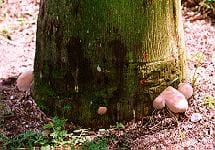Source(s): Jacob G Price
Mature palms are the primary host for Ganoderma zonatum. G. zonatum is a lethal fungal disease in which there are no labeled fungicides. Infected palms are found in all situations and environments. The fungus is an increasing problem in Florida and has occurred in Georgia and South Carolina.
Symptoms/Signs of Infection
First symptom is wilting of older leaves and light green or yellow new leaves. The only positive confirmation of Ganoderma is formation of conks as shown above. Cross section of the trunk at the soil line reveals decay that is widest at the base and travels up the center of the trunk no more than five feet. The presence of any conk on a palm is probably G. zonatum.
Disease Dissemination
G. zonatum is thought to be spread by spores from conks of infected trees.
Disease Management
No fungicides are recommended for the disease. Remove and incinerate conks and the infected portions of the palm along with the stump and roots. Avoid wetting the palm base and mounding mulch next to the trunk. Soil fumigation may help remove spores. Palms should be monitored every six months where no infection has been found and monthly where the disease is confirmed. The length of time between infection and conk formation is not known therefore imported palms may carry the fungus.
Re-planting
Do not plant a palm where an infected palm was removed. No other plant species are infected with G. zonatum so replacement with any other plant material is acceptable.
Resource(s): Common Landscape Diseases In Georgia
Center Publication Number: 117
- Growing Asparagus: A Luxury Vegetable - September 24, 2013
- Frizzle Top in Sago Palms - September 24, 2013
- Growing Onions in the Home Garden - September 24, 2013

